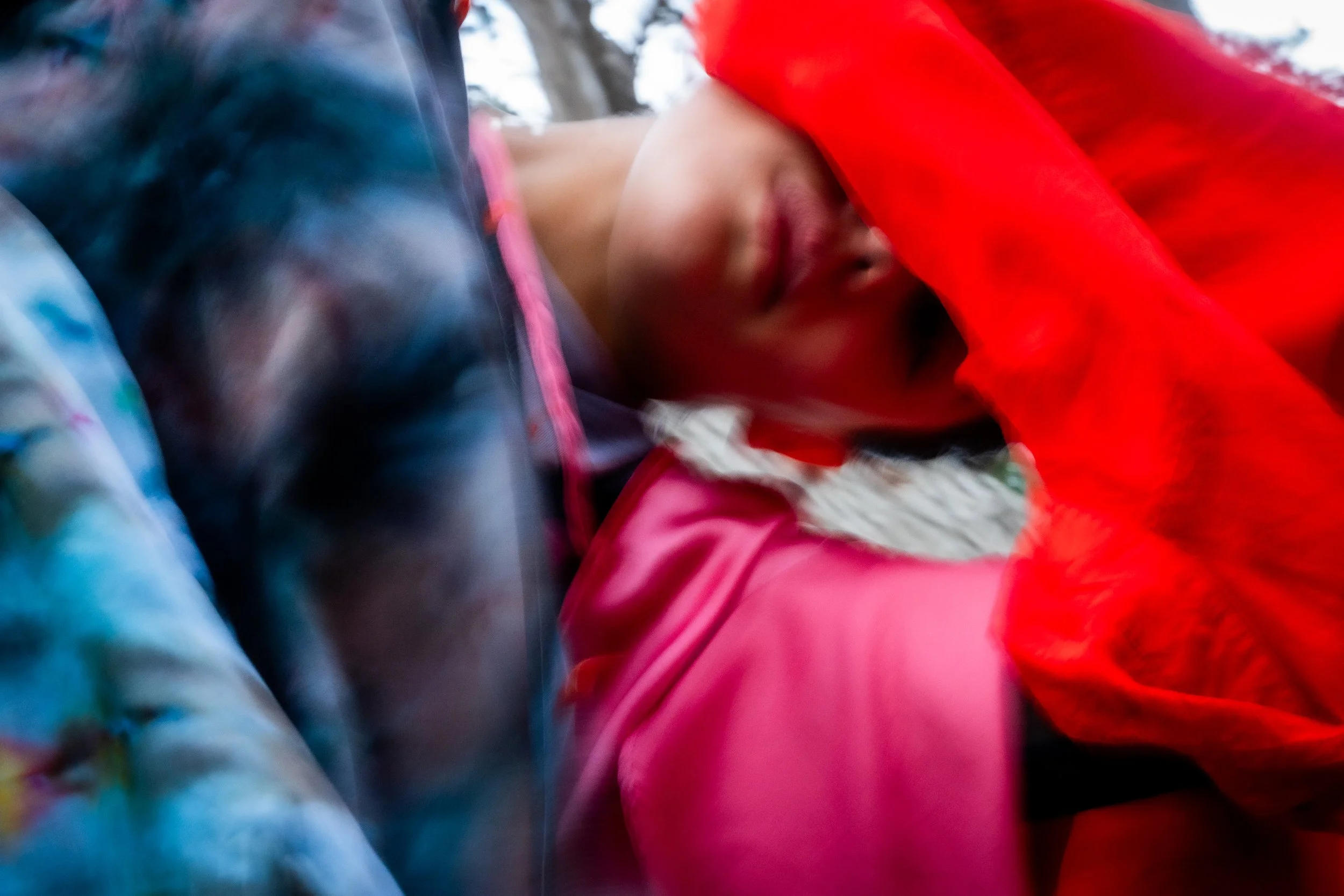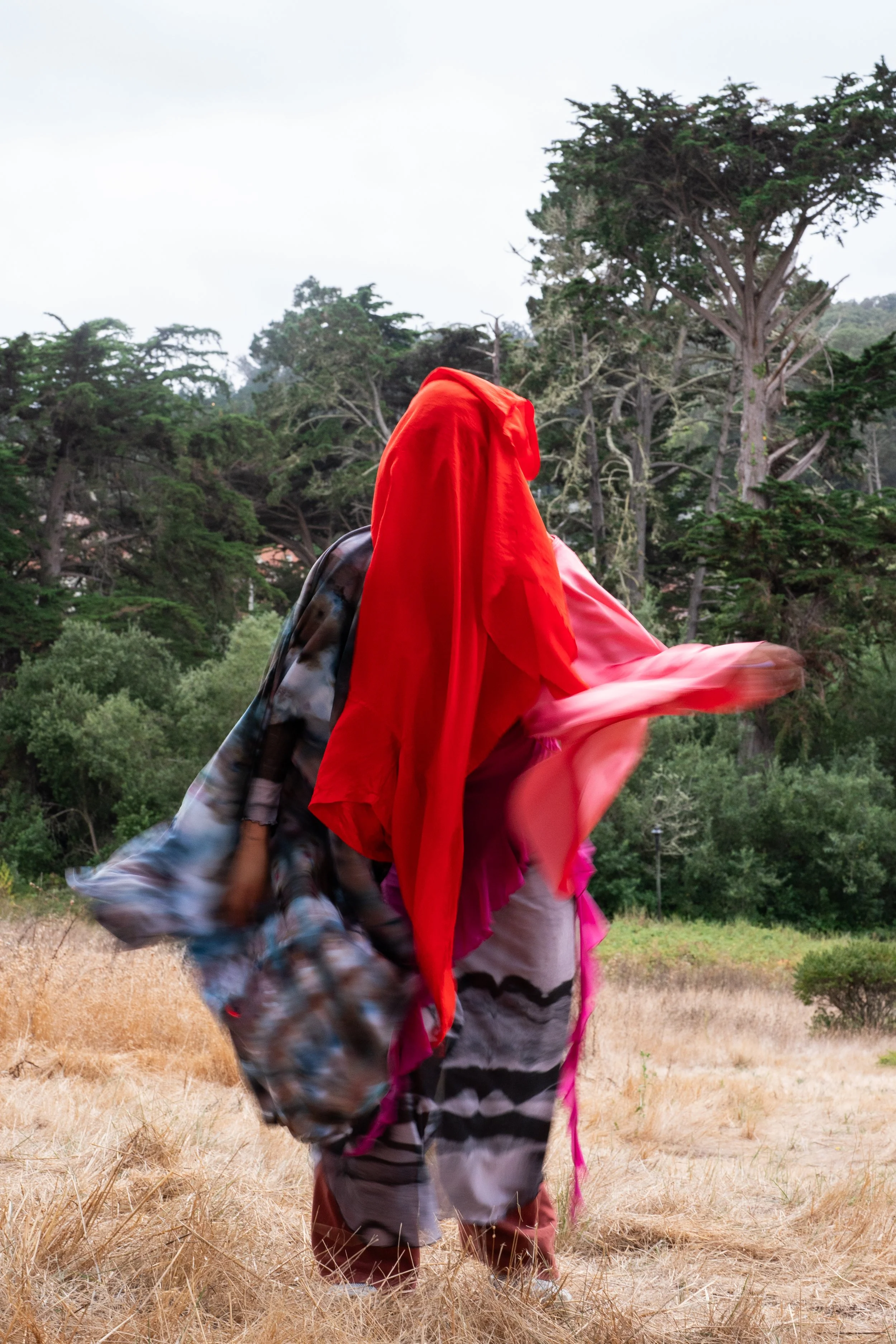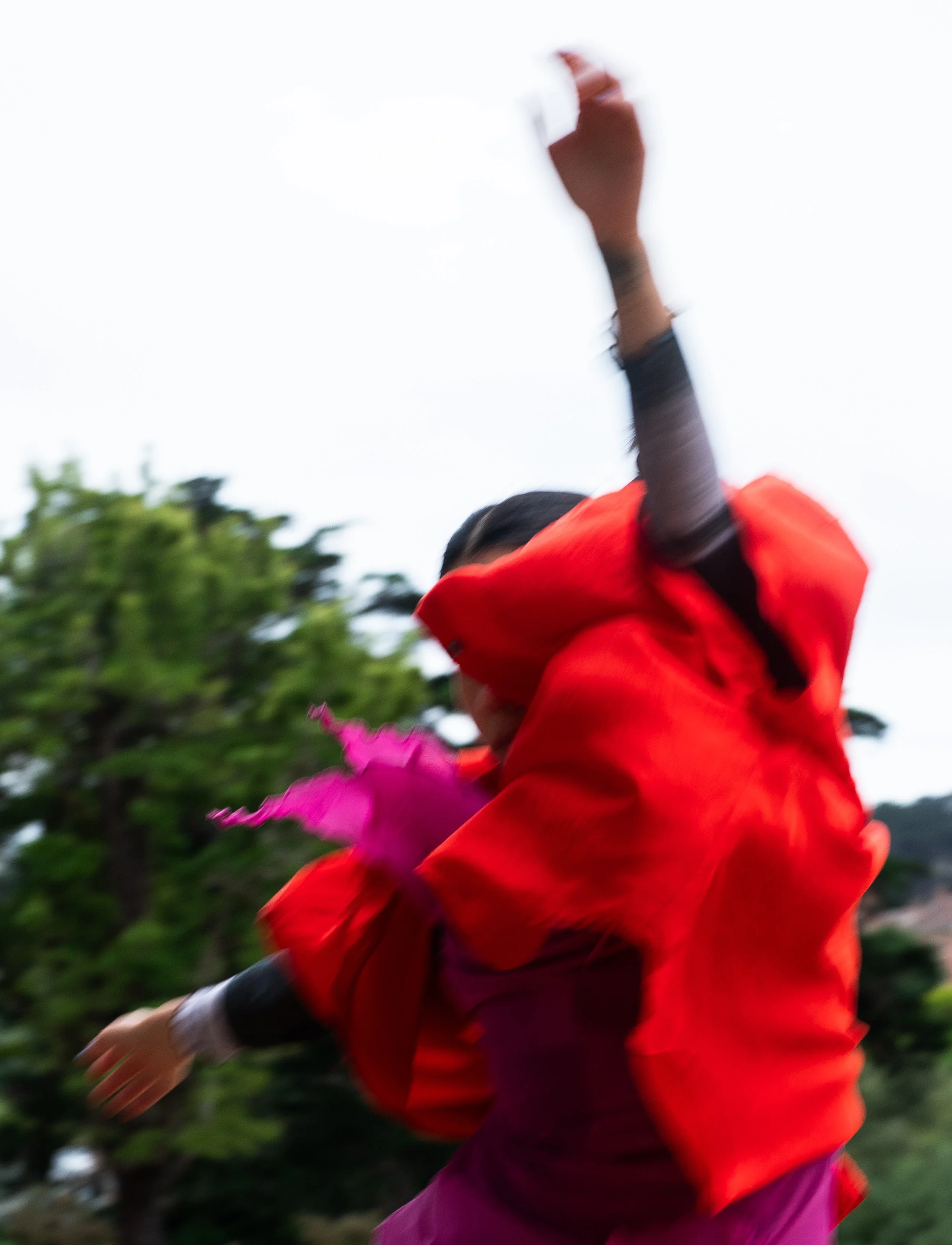gizeh muñiz on florwerk
In this interview, performing artist gizeh muñiz shares the influences that shape her teaching practice and philosophy. They reflect on somatic practice, connection to the land, and Latin American cultural influences on florwerk.
gizeh muñiz dances near the camera. Her face is blurred in motion, her body is draped in flowing garments of pink, red, and blue. The sky is grey and there are trees in the background. Photo taken by Robbie Sweeny.
Chloe Cetinkaya: I took your florwork class last year at the FRESH FESTIVAL and again this year at ROT (a transitional close to the Kathleen Hermesdorf FRESH FESTIVAL). I felt a strong connection with your approach to movement. I come from a somatic background of teaching the Alexander Technique and your class resonated with those somatic ideas. That made me curious about your practice and influences.
I read something about you on the CounterPulse website, "They insist on the importance of 'thinking with the whole body' to imagine possibilities where their identity is not tokenized, but rather a departure point for experimentation, exploration and dance-making". What does “thinking with the whole body” mean for you and how do you use that to imagine the possibilities that you're referring to?
gizeh muñiz: Thinking with the whole body is embodiment. It's breaking the hierarchy that exists in the Western world between mind and body, and understanding that everything works as a whole. So, thinking with the "whole body" is just being a body. It's understanding that we don't have a body, we are a body.
I'm influenced by working with babies and children. One of my mentors for teaching children once observed that I would say, “move your body here, or bring your body here". She told me how, instinctively, children don't create a separation from their bodies.
In dance, the body becomes a concept. Even in somatics, the body becomes a concept. In order to study it, you bring it away from the experience of thinking with the whole body. "Whole body" is about understanding the experience of being a body, understanding that our whole identity is held in every cell of our bodies. So, I related it with tokenization, or representation, because in the United States, I feel there's this need to represent who you are as an identity. There's something about that when it comes to narrative and dramaturgy and creation, that makes me question how much of this kind of representation limits our embodied experience. The body wants to express many things. We are many things more than just a race or a color. The embodiment part of my art practice brings an antidote of understanding creation from a more holistic and wholesome experience.
CC: You describe your classes as “somatic” and I'm interested in what influences and practices “somatic” embodies for you. How do you approach it in ways that don't reaffirm harmful colonial or capitalistic ideas around training bodies? How do you approach it in ways that, as you wrote in your bio for this year's ROT Festival, "divests from concepts of linearity in a creative process with the intention of practicing freedom.”
gm: Bonnie Bainbridge Cohen, says that somatics is basically just entering a process that is already happening. Somatics is just being fully present with whatever is happening already.
I'm from Mexico City, born and raised, and I started dancing when I was older, 21 or 23. I'm 35 now. Before that, I studied acting. The landscape of dance and performing arts in Mexico is extremely strict. I started dancing as a way to workout after I decided that I didn't want to act anymore. I think because I started dancing when I was older, I was extremely committed to my dance practice with all my heart, all my fire, but at the same time, I had this lens of not taking it so seriously. As I started to get more involved in the Dance community, I noticed that resources and opportunities to create in my country are scarce, and that creates an environment of competitiveness and overwork. You feel like you always need to be training more than everyone else. Nervous system wise, it's very stressful.
When I arrived in the United States, I started taking classes with Kathleen Hermesdorf and Sara Shelton Mann and that basically changed my life. I was also introduced to a somatic approach influenced by Bonnie Bainbridge Cohen, and these studies made understanding movement, and who I was as a mover, so much easier. So, I think that, first and foremost, movement training should be tailored towards learning who we are. The somatic techniques I learned brought so much wisdom for me to know who I was as a dancer. I learned that I'm a really good improviser, and also what doesn't work for me.
I think somatic practice is studying the body from a perspective of asking, what is already existing in my body and what can I do with it? But, not just “what can I do with it”, because that brings a utilitarian mind to the body, but more like, what does my body want? Somatics allows me to, instead of having ideas of using my body, collaborate with it. It allows me to have a listening practice and understanding that's genuine. Genuineness is really important for my art practice, for creating. Somatics is approaching the body from this perspective of listening.
I appreciate your question because it's bringing sensitivity to trying to make and do things from a place of questioning. Questions like, how can we do it (somatic practice) in a way that doesn't feel like we're doing this habitual rhythm? What is the time of the body? We're so used to putting our bodies in timelines. I'm really close to a nine month old baby that I've been taking care of since she was three months old, and I'm inspired by her. I think, “it's been three hours, she needs to take a nap”. But, the body doesn't rest every three hours, the body is ready to rest when it's ready to rest. So, having this question of, “what is the time of my body?”, has been a really impactful part of my practice.
When we talk about somatics, something that I notice a lot in practice is that it becomes such an introverted process of feeling and prioritizing. What am I feeling? That's really important in a class environment and also, how do we learn how to do that in community? How can I render my extremely beautiful, amazing personal experience, while staying with a group? This comes from my studies. Just being Latina, this is how we live - we adapt, we're together. We have to let go of our hyper-individualism. We still prioritize, “this is who I am”, but we want to move together.
I was in Colombia in January, and classes there are like a party. It's multi-level, the people who go to the class every day help the people who just started going there. It's this communal environment where everyone is helping each other, everyone is celebrating each other. The teacher doesn't stop to make sure that everyone got it, they're trusting that everyone is present. With that learning from each other, the room becomes horizontal in a way that I like. Another thing that I learned working with children is that it's ideal for them to learn from each other. The younger ones learn from the oldest ones, and the older ones have a role in helping the little ones. They're learning how to be in community, that's really important for me.
Thinking about this idea of linearity, how can we decolonize without losing our fire? There's this spectrum that I noticed when approaching anti-capitalism, of resting but there's not enough tone, not enough exploring your power. So, I think part of my idea in class is about how we put ourselves into an experience. It's not about doing it right or wrong, it's are you allowing yourself to be part of the experience and moving through it?
When you're with children, it's more instinctual. They’re in full trust of their bodies. When I see the people that come to my class, I completely believe in everyone to have the capacity to explore themselves and to take from the material whatever they need to take from the material to be more of who they are as a dancer, instead of moving as they're "supposed" to be.
It's really common that when you start teaching, you stop going to classes. I've noticed that happening to me because I get really tired. I've been going to dance classes lately and it's pretty humbling. Taking classes and putting myself in this vulnerable place of people who take my class seeing me as a student, struggling with something, I think it's amazing. I think it's taking away this hierarchy of the teacher. Even if you're a teacher, you have a lot to learn.
gizeh stands in a field of dried grass with tall, lush green trees behind them. They are covered in colorful garments. Their arm gestures are obscured by fabric and a red scarf is draped over their face. Photo taken by Robbie Sweeny.
CC: I would love to hear more about your work with children. But, I’m also curious about your collaborative project, auiga, with grisel gg torres at CounterPulse. You wrote, “our breathing bodies yield to gravity as a stuttering desire to feel the mutual attraction between our bodies and the land”. Can you talk about this connection to the land and what that means to you?
gm: Land is everything for me. It’s a part of everything that I do. Florwerk is a form that allows us to connect with the land with our hearts. We’re on four-points a lot, our hearts and our whole body is leaning towards the earth. Something I’ve been asking in my practice is, how can I feel more? Maybe not more, but how can I feel my whole potential? How can I embody life? There’s something really passionate and sensual in my way of approaching movement.
I read a book, Becoming Animal, by David Abram a while ago that's really impacting my practice. Basically, my whole philosophy of movement is contained in that book. Abram writes about how the word gravity has a relationship with eros. He dilutes the meaning into, gravity is this mutual attraction that exists between us and the earth, a lack of resistance, wanting to be together. That is extremely beautiful to me – this need to be in it. We don’t fly, we’re here.
I'm working with analog resources in my next project to create a piece. Analog allows you to slow down, to feel, to make mistakes. Anything that brings me into a more grounded, realistic sense of my humanity is important for me. This connection to the land is extremely sensual and that’s why in my class I mention the sensation of sluttiness. There’s something about this erotic part relating with the space that really changes the tone in people’s movement, or at least in my movement. When I propose this prompt (sluttiness), the body immediately becomes alive, it’s really interesting. People understand it. As babies, we have this desire to try everything with our mouth, like eating the soil, we have this really erotic relationship with land. Connection to the land is reclaiming our wildness, reclaiming our wild bodies, and reclaiming our instinct and our intuition. That’s basically the whole practice to me, becoming animal.
CC: Could you talk about the Colombian and Mexican lineage of teachers/movement researchers that have influenced you?
gm: Starting to dance later in life allowed me more agency to choose what I liked and what I wanted to focus on. Florwerk was always really delicious for me. I loved it, it felt amazing. I always wanted to do more and it was such an amazing experience that I wanted to keep doing it – everything about florwerk and the philosophy of community.
enNingunlugar is a collective in Mexico, one of its kind. The work that they do is incredible and I’m a huge admirer and follower of their work, and they’re my friends! Humberto Vega (one of the collective’s founders) was my teacher and we really connected and would talk about the philosophy.
Flowerk is a research that has been happening in Latin America for over 30 years or so, that really comes from black and brown bodies. It comes from break dancing and David Zambrano. The florwerk that we see in the world today has so much influence from Latin America. How a lot of the culture of Latin America has been translated to me through florwerk, not just through specific teachers, isn't something I would really understand until I came to the United States. The culture in class, this party environment of supporting each other energetically, no one teaches you how to do that, it just happens. There's a warmth that happens in the group. The way florwerk was translated to me was all about community, it was all about dancing together. That’s really important in my class. Humberto was really diligent and specific about that in his class.
No one ever told me, “this is about connecting with the land”, but florwerk was just so instinctively related to that for me. I would see it in the bodies when I looked at Colombian dancers, it’s impressive to see people, how they move. In general, my biggest influence is the culture of being Latina and how that has impacted my teaching and the form of learning from a more instinctive and intuitive place. Like learning from a baby.
CC: I have two more questions, feel free to answer either or both. You describe your florwerk class as being, “ideal for all curious bodies that are interested in deepening their movement practice beyond form”. What part of all this is beyond form?
My last question is about your project, auiga, you wrote, “this piece is a poem that contains us to daydream together”. What does that look like for that piece?
gm: I think part of this, “bring your curious body and deepen your movement practice”, is thinking outside of form. Right now, I’m slowly adventuring into working in specificity. What is the balance between the experience of collaborating with the body and for everything to be specific? When things become so liquid, permissive and delicious, I’m really curious about how we can bring our full agency to our experience and at the same time work in specificity together. I feel like doing this is a way of spell-casting, like conjuring. If we’re all putting all of our attention in one single thing, I feel like the world can change.
I think form is an excuse. I do florwerk because I love it and I have so much respect for it. Florwerk is my main movement language. If I was into any other form, the teaching would probably be the same, but with a different movement language. My teaching is not about the form, not about the florwerk. The teaching is more about how we are connecting to the land.
How we connect with ourselves is an antidote for capitalism. Just feeling is an antidote for capitalism. If we create spaces where we can feel and be in a collective, that’s really impactful. That’s why I’m talking about form, because florwerk has become such a trend that it is more about who can do the most tricks. I like tricks, but it's not about that for me. It’s about, how is my body experiencing this? How is my body experiencing being so close to the floor and doing something that feels difficult? It's about bringing more of the depth of the practice rather than just the form of doing jumps and turns in the air.
The last question, about daydreaming, I feel really committed to creating spaces where we can daydream together. I don’t like manipulating people into seeing what I want them to see. I really believe that creating a space where people can hear their thoughts and have a moment of daydreaming, of creating these moments of connection with everything and with yourself, feels really relevant. I think there’s power in creating a state rather than creating a really specific representation of something, an idea. That’s why I’m interested in embodying rather than representing something, it’s really important to me.
Dance allows me to stay in a state of wonder, like a baby. Abstraction helps me to create spaces where things, stories or experiences, are translated through and with the body. I think that’s why it brings me into really preverbal states of being. It's really present. It’s understanding that there’s a different way of communicating that is not only with words.
CC: I’m really grateful for this opportunity to dig deeper into your thought process and how you teach.
gm: Thanks, Chloe. Thanks for listening and asking the questions. It’s always amazing to reflect on everything.
gizeh dances surrounded by trees. Their arms are outstretched, one reaches out as the other extends towards the sky. The edges of their body are blurred by motion. She is wearing bright red and fuchsia garments that billow in the force of her momentum. Photo taken by Robbie Sweeny.
Bio: gizeh moves, teaches and performs. She is from Mexico and is currently co-existing in Ohlone territory. Dedicated to the study of being a breathing body. They recreate body stories through touch, relationship, movement and stillness to explore new paradigms of temporality, relationality and intimacy. An improviser and composer devoted to witness beauty and the cultivation of wonder and curiosity. She listens to the dialogue created from, with, and through their body and her movement practice is fluent in floor work, somatic practices and deep listening. For more information visit: https://gizzeh.com/ and follow her on Instagram @gizzeh


